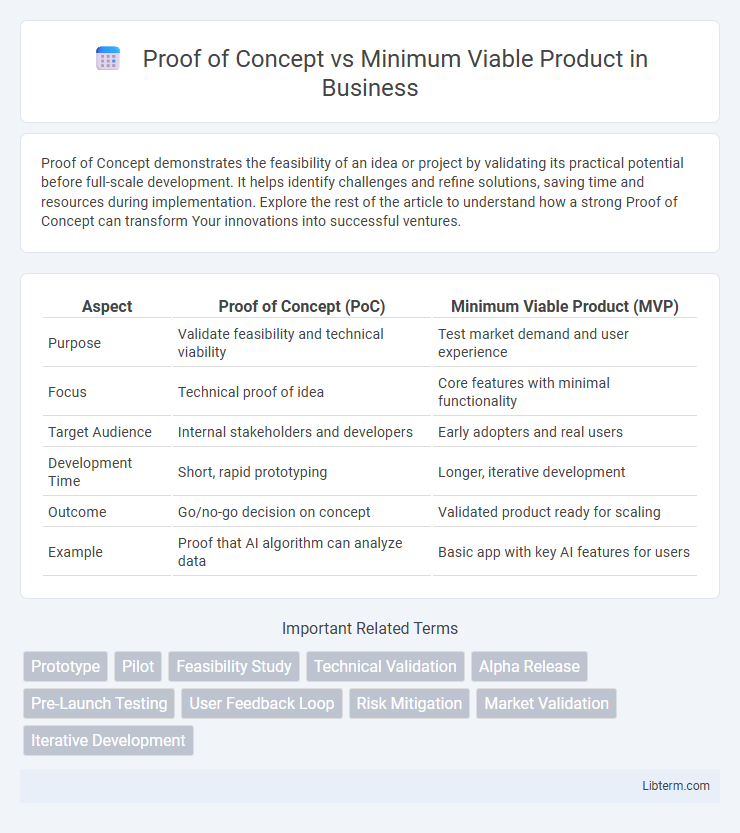Proof of Concept demonstrates the feasibility of an idea or project by validating its practical potential before full-scale development. It helps identify challenges and refine solutions, saving time and resources during implementation. Explore the rest of the article to understand how a strong Proof of Concept can transform Your innovations into successful ventures.
Table of Comparison
| Aspect | Proof of Concept (PoC) | Minimum Viable Product (MVP) |
|---|---|---|
| Purpose | Validate feasibility and technical viability | Test market demand and user experience |
| Focus | Technical proof of idea | Core features with minimal functionality |
| Target Audience | Internal stakeholders and developers | Early adopters and real users |
| Development Time | Short, rapid prototyping | Longer, iterative development |
| Outcome | Go/no-go decision on concept | Validated product ready for scaling |
| Example | Proof that AI algorithm can analyze data | Basic app with key AI features for users |
Introduction to Proof of Concept and Minimum Viable Product
Proof of Concept (PoC) validates the feasibility of a technology or idea by demonstrating its practical potential on a small scale, ensuring technical viability before proceeding. A Minimum Viable Product (MVP) focuses on delivering a functional product with core features to early users, enabling market testing and iterative development based on real user feedback. Both PoC and MVP are essential in the innovation cycle, with PoC addressing technical risk and MVP targeting market validation.
Defining Proof of Concept (PoC)
A Proof of Concept (PoC) is a preliminary demonstration to verify that a certain concept or theory has practical potential and technical feasibility. It aims to validate critical assumptions and reduce risks before investing significant resources into full-scale development. PoCs are typically small-scale, experimental projects designed to prove that key functionalities or technologies can be successfully implemented.
Defining Minimum Viable Product (MVP)
A Minimum Viable Product (MVP) represents the most basic version of a product that includes only essential features to meet early adopters' needs while allowing for user feedback and iterative improvement. This approach minimizes development time and costs by validating core hypotheses through real-world use before full-scale production. MVPs help businesses efficiently test market demand and refine product direction based on actionable insights, reducing risk and optimizing resource allocation.
Key Differences Between PoC and MVP
Proof of Concept (PoC) validates the feasibility of a specific idea or technology, aiming to prove that a concept can be developed and function as intended, often through small-scale experiments. Minimum Viable Product (MVP) delivers a functional product with core features to gather user feedback and test market demand, focusing on usability and value for early adopters. PoC emphasizes technical viability, while MVP prioritizes customer experience and iterative development for product-market fit.
Objectives of PoC vs MVP
Proof of Concept (PoC) primarily aims to validate the feasibility and technical aspects of an idea or technology, ensuring that it can be developed into a functional product. Minimum Viable Product (MVP) focuses on delivering a basic, usable version of the product to early adopters to test market demand and gather user feedback for iterative improvement. PoC addresses risk reduction through technical validation, while MVP emphasizes user experience and business viability.
Development Process: PoC vs MVP
Proof of Concept (PoC) in the development process aims to validate technical feasibility and core assumptions with minimal resources, often using prototypes or simulations. Minimum Viable Product (MVP) focuses on delivering a functional version of the product with essential features for early user feedback and market validation. PoC precedes MVP by addressing "can we build this?" while MVP addresses "can users benefit from this?" enabling iterative improvements based on real-world usage.
Use Cases: When to Choose PoC or MVP
A Proof of Concept (PoC) is ideal for validating technical feasibility or a specific functionality before significant resources are committed, often used in early-stage innovation or highly uncertain projects. A Minimum Viable Product (MVP) is best suited for testing market demand and user experience with a functional product version, enabling real user feedback and iterative development. Choose PoC when the primary risk is technical validation, and select MVP when the goal is to assess customer acceptance and refine features based on user data.
Benefits and Limitations of PoC
Proof of Concept (PoC) validates the feasibility and technical potential of an idea, minimizing initial risks and guiding resource allocation before full-scale development. PoC benefits include early identification of technical challenges and confirmation of concept viability, which reduces costly errors in later stages. Limitations arise from its limited scope, often lacking user feedback and market validation that a Minimum Viable Product (MVP) provides.
Benefits and Limitations of MVP
A Minimum Viable Product (MVP) enables startups to validate key hypotheses with real users, minimizing development costs while accelerating time-to-market. Its primary benefit lies in gathering authentic user feedback to iteratively improve the product, reducing the risk of building unwanted features. However, MVPs may omit essential functionalities, potentially resulting in a suboptimal user experience that can harm brand perception and limit early adoption.
Choosing the Right Approach for Your Project
Selecting between a Proof of Concept (PoC) and a Minimum Viable Product (MVP) hinges on your project's objectives and stage of development. A PoC is ideal for validating technical feasibility and addressing critical risks early, often used in experimental or innovative projects. An MVP focuses on delivering core functionalities to early users, enabling market feedback and iterative improvements for product-market fit.
Proof of Concept Infographic

 libterm.com
libterm.com